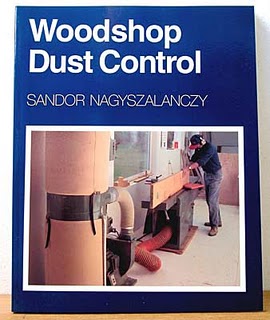
Workshop Dust Collection

Whether you have a commercial woodworking shop or a weekend warrior garage-sized shop, controlling wood dust in a small shop is an important consideration for your health.
When purchasing a dust collector determine the dust collectors CFM requirement and what you need for your shop. There are so many sites on the Internet to guide you in doing this. The book Wood shop Dust Control, by Sandor Nagyszalanczy is an excellent source.
Small one-person shops don’t need an expensive central system. If you typically work alone in a space less than 600 square feet, then a 1-1/2 or 2 HP Dust Collector is all you need.
The CFM for the entire shop may exceed the capacity for the dust collector. In my case, I used blast gates will allow machines not in use to be isolated from the dust system by closing off those machines.
There are several things to consider when thinking about dust collection:
1. Collecting large dust at the source
2. Collecting small dust in the air.
3. Protecting your lungs with a dust mask.
Collecting large dust at the source
Controlling wood dust in a small shop usually means installing adust collector. Try to place it in an out of the way spot, unused corner of the shop.
I wired the control switch close to my most used and biggest dust making tools. In my case, my table saw, router and shaper. Above that switch is a remote control for an air filter, discussed later.
Once I located where to put my dust collector I then attached it to a pre– separator cyclone attachment. The cyclone attachment can be bought at wood working supply sites and is basically a chip separator.
It saves from emptying the collector bag by separating and collecting the heavier wood chips and letting the finer dust go into the dust collectors bag.
My cyclone dust separator attachment sits on top of a metal garbage can with the dust separator lid which connects to the systems “main truck line” by a flexible black hose.
The cyclone dust separator is connected to the 4″ white plastic main trunk line which runs the length of my shop.
Along this trunk line I installed “Y” connectors and “blast gates” to control and isolate the suction of the system.
4″ flexible hoses run from the main trunk line to my individual machines. [Shaper machine below]
Every machine you want to collect dust from needs to be ultimately fitted with a 4″ male fitting so the flexible hose can attach to it. [Jointer – below]
Many newer machines come with a 4″ port, e.g., most jointers, planers and table saws. My machines did not and I needed to attach specialty hoods [black hood above] to fit to my machines and attach to the 4″ flexible hose. I used self tapping machine screws to install them.
On my cut off table saw, below, I had to modify an area below the saw to mount the dust hood. I wanted to mount it under and close to blade.
Controlling wood dust in a small shop
I used a plywood base with a cut out for the dust hood. The 4″ hose runs up under and attached to the dust hood.
In order to collect dust at my “raised panel” machine I needed to make a plywood box near the cutter, and then attached a commercially available “universal” dust hood to receive my flexible hose. [photo below]
My main table saw is my longest run and has a wide sweeping elbow which I’d rather avoid but can’t. I secured the hose and piping to the table saw back and adjacent router table with “U” shaped clamps and screws.
For smaller tools like my your router table below, sander and chop saw, which have 2″ dust ports, I used reducers to connect the 4″ pipe to 2″ pipe.
Miter “chop” saw below. The white 4″ pipe is reduced to a flexible 2″ pipe
My hand held power tools like my random orbit sanders, belt sanders, and biscuit jointers are connected to a small diameter flexible hose and can connect to almost any port in the shop with an adapter. Many times I find it easier to attach them to my shop Vac which is equipped with a HEPA filter.
Replacing the dust collectors top bag with a bag that is designed to trap small dust particles (down to one micron) without seriously impeding the air flow of the dust collection system. These bags keep the finer dust made from sanding from going
through the dust collectors bag and into the air.
Collecting dust in the air:
It’s super important to install and use an air filter. Dust particles are measured in microns. Dust particles under 10 microns constitute the primary respiratory health risk to woodworkers.
Photo: Delta # 50-875 3-Speed Air Filtration System with Remote
Fine dust particles float through the air in your shop for a surprising length of time and can end up causing mild allergic reactions to severe and chronic respiratory ailments.
I installed my filter near my table saw and sanding area.
Protecting your lungs with a dust mask:
When sanding wood wear a dust mask. I suggest finding a mask that has an inhale valve and a separate exhale valve. These respirator dust masks have several advantages over the single disposable type. First, you’re not breathing in and out of the filter media and the moisture from your breath helps keep your safety glasses from fogging up.
Vacuum with a HEPA filter ~ Sweeping just stirs up the dust:
The last step in dust collection is to vacuum the machines, flat surfaces and floor. Make sure your vacuum is equipped with a HEPA filter or you will end up spreading more dust through the vacuum’s exhaust port.
One Man’s Workshop dust Collection Solution
If you enjoyed this post, please consider commenting or subscribing to receive my future posts via email
